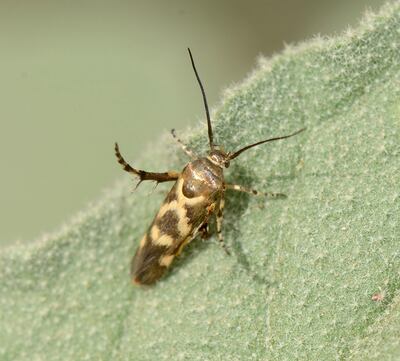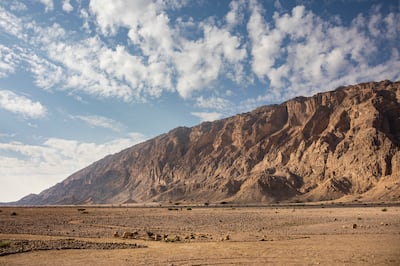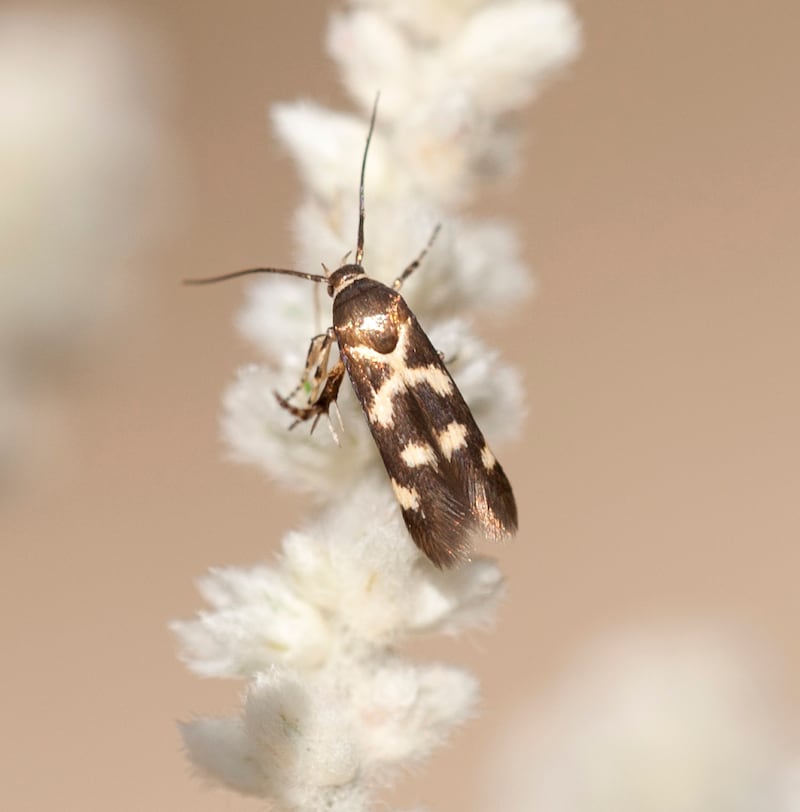A new species of moth has been discovered on Jebel Hafeet in Al Ain.
It was spotted by wildlife researcher Huw Roberts and has been named Eretmocera hafeetensis after the mountain it was found on.
It is part of the Scythrididae family of moths and is distinguished by a unique “X” marking.
Details about the unique find have been published in the journal, Nota Lepidopterologica, with the discovery highlighting the rich biodiversity of Jebel Hafeet, which is home to some of the UAE’s rarest plants and engendered animals.
Mr Roberts, who has been studying the flora and fauna of the UAE for the past two decades, first spotted the moth on the mountain in 2010.
X marks the spot
“The X shape made me convinced it was different,” Mr Roberts told The National. "But I knew that it needed a detailed examination to be sure it was a new species."

The painstaking work to identify it as a new species continued since that first encounter. Mr Roberts undertook several field visits to a western part of the mountain known as Ain Al Waal, where most of the sightings of the moth were made.
There he took photographs, studied them at home and sent specimens to Sweden for further study. Working with another expert, Bengt Bengtsson, they finally identified it as a new species before jointly writing the journal article.
The moth has a metallic brown-colour with pale markings. It can be identified by an X-shape across the two forewings, a feature more prominent on females.
A nature hotspot
The find further underlines the rich biodiversity of the UAE and particularly on Jebel Hafeet. Not only is it Abu Dhabi’s highest peak at about 1,200 metres but on its slopes are trees, plants, birds and animals such as the red fox, Blanford’s fox, Brandt’s hedgehog, bats, hares, the Arabian tahr and the rock hyrax.
“Mountains are attractive for many species," said Mr Roberts. "With Jebel Hafeet, there is always a chance of finding interesting species, partly because Jebel Hafeet is isolated from the rest of the Hajar Mountains by about 40km," he said.
“Also, it is quite different climatically [less rain] and geologically [different rocks], which influence what plants that grow and which animals are present.”

In recognition of the importance of the area, Abu Dhabi established the Jebel Hafeet national park to protect the unique mountain environment.
Part of the Ain Al Waal site lies inside the park. The moth has been seen mostly at Ain Al Waal and a site close to it known as Ain Al Fayda but it could be found elsewhere on the mountain or anywhere with the right conditions.
Moths and their caterpillars are crucial for healthy ecosystems as they are part of the food chain for other species such as bats, birds, small mammals and amphibians. They also pollinate flowers.
Mr Roberts, who has been based in Al Ain for about 20 years, is also working on a larger wildlife project at Ain Al Waal. He has focused on an area measuring 900 metres by 700 metres between the mountain and a road that provides a barrier between it and a new residential development.
The location has trees and plants while several wadis feed into this area, with water pools used by Arabian tahr. Mr Roberts has, so far, documented close to about 850 species of fauna in this area and he plans to publish the results soon.

“It surprised me there were so many species in such a small area,” said Mr Roberts, whose work has been previously aided by a grant from the Mohamed bin Zayed Species Conservation Fund.
“The species change with the seasons,” he said. “Spring, with its flowering plants, is the best time of year to see a variety of wildlife species."
Mr Roberts said it was important to try to keep these and similar species-rich areas safe for future generations.
“Many of the species in this area could easily be lost quickly if it is not actively protected,” he said.
“Just in the past ten years, things have changed. There are many people living nearby now. The area is a biodiversity hotspot just a few metres away from a large housing estate.”







